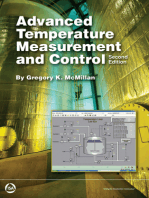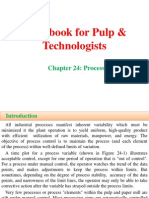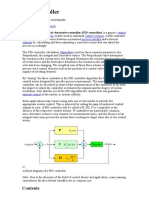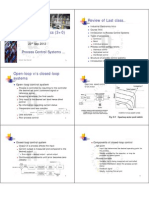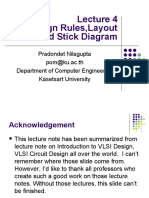Process Control
Process Control
Uploaded by
FakharAbbasCopyright:
Available Formats
Process Control
Process Control
Uploaded by
FakharAbbasOriginal Description:
Copyright
Available Formats
Share this document
Did you find this document useful?
Is this content inappropriate?
Copyright:
Available Formats
Process Control
Process Control
Uploaded by
FakharAbbasCopyright:
Available Formats
WESCHLER INSTRUMENTS
Process Control
Most industrial processes require that certain variables such as
temperature, flow, level or pressure, remain at or near some reference value
(setpoint). Closed-loop control is used to achieve this. The process controller
looks at a signal representing the process value, compares it to the desired
setpoint and acts on the process to minimize the difference (error).
The method used by the controller to correct the error is the control mode.
The four most popular control modes are on/off, proportional, integral
and derivative.
Control Modes
On /off control activates an output until the measured value reaches the
reference value. A common example is the household thermostat. No control
action takes place until the measured value deviates from the setpoint by a
minimum amount (deadband). The output then goes from full off to full on,
turning off again when the setpoint is reached. While simple and low cost,
this mode of control has a tendency to overshoot the desired value. A digital
panel meter with relay output and adjustable setpoint can be used for on-off
process control.
A more refined control method is proportional control. Here the difference
between the setpoint and measured value generates a continuous, linear
control output. The control gain K sets the system response as a function
of time:
Output(t) = K [Setpoint - Measured(t)] + Bias.
The bias term creates a non-zero output when the error term is driven to zero.
This allows bi-directional control. The proportional band is the span of the
measured variable that causes a full range output.
The higher the gain,
the more the output
will change for a given
change in
measurement or
setpoint. High K
(narrow band)
provides more precise
control, but can create
stability problems.
Low K (wide band)
controls over a wider
input span, but may
be slower to respond. In proportional control, if system loading requires a
shift in operating point, a
difference between the
measurement and set point
will exist at equilibrium. The
higher the system gain, the
lower the offset will be for a
given load change.
Controllers with reset
(integral) action will
automatically recenter the
proportional band around
the offset bias level. An integral mode controller responds to the integral of
the difference between the setpoint and measured value. The adjustable
parameter for integral control is the integral time T, or the reset rate 1/T.
The integral mode is sometimes used as a single mode of control but is more
commonly used with proportional control. This is known as two mode PI
control (see Process Control Modes chart on next page). In processes
requiring relatively low gain, the integral mode continues to drive the output
even when the proportional error is zero. This combination generates a
smaller total error than either mode operating alone.
The derivative mode is commonly called rate control because its output is
based on the rate of change of the measured variable. This mode is rarely
used alone. It is typically combined with proportional control to form PD
control or with proportional and integral control in a three mode PID
controller. The derivative term anticipates changes to reduce overshoot. A
variant of the derivative mode uses the derivative of the measured variable
rather than the derivative of the difference signal. This can speed response
to large process shifts but slows the response to a setpoint change.
Although most PID controllers use proportional outputs, PID control can also
be used with on/off outputs by incorporating duty cycle modulation. For
each time interval (cycle time), the controller adjusts the on time in response
to the control signal magnitude. Since this generates frequent on/off
operations, solid state outputs are recommended over mechanical relays.
Non-linear controllers may be preferred for processes that are highly
non-linear, such as pH. The standard control modes of proportional,
integral and derivative are superimposed on a non-linear function.
Non-linear controllers can also be used to filter noise or pulsations, while
permitting effective control over large disturbances.
A single loop controller handles one process input. Multi-loop controllers
can simultaneously control more than one process variable. Controllers with
digital communication capability are often called distributed controllers.
Some controllers can also retransmit the process variable or error signal in
analog form for display on a remote indicator.
Tuning
Tuning is a critical but often confusing aspect of proper controller
application. Many reference books and on-line forums are dedicated to
tuning issues. Tuning can be optimized for load changes, setpoint changes
or other factors. Open loop tuning involves breaking the feedback path and
characterizing the system response. Closed loop characterization can be
done with the feedback loop intact, by introducing a known disturbance and
monitoring the response. The controller can then be manually adjusted for
the signal ranges, time constants and delays of the process. This can be a
complex and lengthy task. Fortunately controllers often include automatic
tuning capabilities to learn a process and set the appropriate
control loop parameters.
Signal conditioning
Many process controllers can be connected directly to the process sensor,
such as a thermocouple or RTD. In some cases, an additional transducer
or signal conditioner is required to convert the physical parameter to an
electrical signal that can be handled by the controller. Many of the new
'smart' sensors include this signal conditioning, eliminating the need for
an additional module. Transducers are also needed to convert some
electrical parameters, such as AC power, into a signal compatible with
the controller's input.
181
WESCHLER INSTRUMENTS www.weschler.com 800-903-9870 fax: 800-903-9590 info@weschler.com
You might also like
- Building Management System - BMS 1Document31 pagesBuilding Management System - BMS 1jaffna100% (2)
- Advanced Temperature Measurement and Control, Second EditionFrom EverandAdvanced Temperature Measurement and Control, Second EditionNo ratings yet
- High Voltage Pulse Generator FPG 20-10NKS10 (Type 2)Document8 pagesHigh Voltage Pulse Generator FPG 20-10NKS10 (Type 2)Naqib UllahNo ratings yet
- ProcessControl PDFDocument2 pagesProcessControl PDFfaisal84inNo ratings yet
- Automatic Controllers & Control ModesDocument74 pagesAutomatic Controllers & Control ModesVishal IyerNo ratings yet
- DDCDocument22 pagesDDCBala SrivasNo ratings yet
- Bms For HvacDocument63 pagesBms For HvacWasantha Jayarathna100% (1)
- Chapter 1Document22 pagesChapter 1Anonymous AFFiZnNo ratings yet
- Introduction To Direct Digital Control Systems: Purpose of This GuideDocument82 pagesIntroduction To Direct Digital Control Systems: Purpose of This GuidekdpmansiNo ratings yet
- Technical Reference - Tuning A PID ControllerDocument6 pagesTechnical Reference - Tuning A PID ControllerMelchor VasquezNo ratings yet
- CHAPTER 14 RogelioDocument6 pagesCHAPTER 14 Rogelioultrakill rampageNo ratings yet
- PIDControlDocument2 pagesPIDControlchatty8567% (3)
- Chapter - 4 Control Configuration 4.1 Pid ControllerDocument8 pagesChapter - 4 Control Configuration 4.1 Pid ControllerMoorthy ManikandanNo ratings yet
- Control SystemDocument7 pagesControl SystemLeo LonardelliNo ratings yet
- Automation 2 Topic 1: Design A Simple Process Control SystemDocument12 pagesAutomation 2 Topic 1: Design A Simple Process Control SystemChriscarl De LimaNo ratings yet
- Control SystemsDocument18 pagesControl Systemsgayatri jaltareNo ratings yet
- Mechatronics (1) .34 9Document57 pagesMechatronics (1) .34 9Anonymous p8bHAAxNo ratings yet
- PID Controller: Navigation SearchDocument8 pagesPID Controller: Navigation SearchprashantshivanagiNo ratings yet
- NI Tutorial 3782 enDocument4 pagesNI Tutorial 3782 enhiperboreoatlantecNo ratings yet
- Process Control and Common TermsDocument210 pagesProcess Control and Common TermsGeorge Markas100% (2)
- NI Tutorial 3782 enDocument4 pagesNI Tutorial 3782 enpetergoodingNo ratings yet
- PID ControlDocument11 pagesPID Controlhd03No ratings yet
- Chapter 24 Process ControlDocument36 pagesChapter 24 Process Controlavandetq15No ratings yet
- Auto1 Kupe6 Co2 Resurreccion DefinitionsDocument4 pagesAuto1 Kupe6 Co2 Resurreccion DefinitionsaltheiaarabeeeNo ratings yet
- Control System - WikipediaDocument8 pagesControl System - WikipediafwefNo ratings yet
- Tuning PID ControllersDocument3 pagesTuning PID ControllersSatsih KumarNo ratings yet
- Pid EeeeDocument28 pagesPid Eeeecyprian obotaNo ratings yet
- Working or Operation of PID ControllerDocument7 pagesWorking or Operation of PID Controllerjohn glenn magnoNo ratings yet
- PID ControllersDocument9 pagesPID Controllerszs94qjqcx7No ratings yet
- PID ControllerDocument7 pagesPID ControllerPromise EnyinnayaNo ratings yet
- Pid Control TheoryDocument8 pagesPid Control TheorySonu SinghNo ratings yet
- PID ControllerDocument17 pagesPID Controlleradetag0% (1)
- PID ControllerDocument10 pagesPID ControllerFarid HazwanNo ratings yet
- PID ControllersDocument58 pagesPID Controllerss12originalNo ratings yet
- Close Loop Control Sys IntroDocument7 pagesClose Loop Control Sys IntroDwi Mulyanti DwimulyantishopNo ratings yet
- Experiment No.1: Now Manually Move The AVS-1 Bar To Control The Flow Through The Valve in To The ContainerDocument16 pagesExperiment No.1: Now Manually Move The AVS-1 Bar To Control The Flow Through The Valve in To The ContainerfahadfiazNo ratings yet
- 2023 PCI360S Introductory ConceptsDocument19 pages2023 PCI360S Introductory ConceptsSifanele PotwanaNo ratings yet
- IPCDocument15 pagesIPCu can't see meNo ratings yet
- Fundamentals of ControlDocument5 pagesFundamentals of Controltoony reyesNo ratings yet
- Final Exam - Electronics 3Document11 pagesFinal Exam - Electronics 3Eugene Embalzado Jr.No ratings yet
- Auto 2 FinalsDocument5 pagesAuto 2 Finalsjohnrossreyes0924No ratings yet
- Mechanically Operated Switches2Document7 pagesMechanically Operated Switches2VrxDxnNo ratings yet
- Temperature Control LabDocument16 pagesTemperature Control Labhoocheeleong234100% (1)
- W7ADocument15 pagesW7AShujah RashidNo ratings yet
- Chapter 3 IPCDocument53 pagesChapter 3 IPCkirubelNo ratings yet
- Process Control SystemsDocument3 pagesProcess Control SystemsHammad Ansari100% (1)
- Presentation-8 CONTROLLERSDocument52 pagesPresentation-8 CONTROLLERSaengradnanNo ratings yet
- Industrial Process Control Basic ConceptsDocument39 pagesIndustrial Process Control Basic Conceptskaezzar10100% (2)
- RapbehDocument1 pageRapbehTristan SisonNo ratings yet
- How A Control Valve Fixes Response Time 1689867528Document3 pagesHow A Control Valve Fixes Response Time 1689867528Warda YousafNo ratings yet
- General: P - A - R - TCDocument18 pagesGeneral: P - A - R - TCMohamed MosaedNo ratings yet
- PidDocument21 pagesPidSandesh Kumar B VNo ratings yet
- CH 2Document17 pagesCH 2Dawit BonoyaNo ratings yet
- Automatic Motor Start/stop: Temperature ControlDocument19 pagesAutomatic Motor Start/stop: Temperature ControlNathaniel ConiseNo ratings yet
- 0 InrtoductionDocument33 pages0 Inrtoductionmohamed ramadanNo ratings yet
- PID ControllerDocument18 pagesPID ControllerCheng Khie Chieh100% (1)
- Embedded Systems and Control Systems': An Open-Loop ControllerDocument5 pagesEmbedded Systems and Control Systems': An Open-Loop Controllermohed_kamalNo ratings yet
- 15 Homeostasis: NameDocument2 pages15 Homeostasis: NameFakharAbbasNo ratings yet
- Australia Awards Pakistan Information For IntakeDocument3 pagesAustralia Awards Pakistan Information For IntakeFakharAbbasNo ratings yet
- Grade 3 Assessment Test October 20173Document3 pagesGrade 3 Assessment Test October 20173FakharAbbasNo ratings yet
- RPA2014 TeacherDocument120 pagesRPA2014 TeacherFakharAbbasNo ratings yet
- Methyl Ethyl Ketone: Cautionary Response InformationDocument2 pagesMethyl Ethyl Ketone: Cautionary Response InformationFakharAbbasNo ratings yet
- Pakistan Nuclear Regulatory Authority: Postgraduate Fellowships atDocument1 pagePakistan Nuclear Regulatory Authority: Postgraduate Fellowships atFakharAbbasNo ratings yet
- Water InjectionDocument2 pagesWater InjectionFakharAbbasNo ratings yet
- GLE IMEM TREND Fault 67-71Document7 pagesGLE IMEM TREND Fault 67-71Ash100% (1)
- Vaporizador: Equipment Data SheetDocument1 pageVaporizador: Equipment Data SheetAlonso DIAZNo ratings yet
- Yale YJLHook - YJC680 PDFDocument36 pagesYale YJLHook - YJC680 PDFscofiel1No ratings yet
- Physics Investigatory ProjectDocument24 pagesPhysics Investigatory Projectahmadshaheerbilal2016No ratings yet
- MDDRC10Document10 pagesMDDRC10Udit RayNo ratings yet
- Lecture Notes On SYNCHRONOUS GENERATORDocument72 pagesLecture Notes On SYNCHRONOUS GENERATORJeremiahNo ratings yet
- LONG Wo EXAM-Q3-TLE 10Document4 pagesLONG Wo EXAM-Q3-TLE 10Hajie RosarioNo ratings yet
- 1-100 Chapter 3 ReviewerDocument5 pages1-100 Chapter 3 ReviewerBlessie Joy DalinaNo ratings yet
- Index Penomoran Relay Proteksi Pada Sistem KelistrikanDocument1 pageIndex Penomoran Relay Proteksi Pada Sistem KelistrikanDavid Halomoan MalauNo ratings yet
- Coolaudio V2902 DatasheetDocument19 pagesCoolaudio V2902 DatasheetKoddi NextNo ratings yet
- 3.main LT Panel-2000a - 24.01.24Document11 pages3.main LT Panel-2000a - 24.01.24SubhadipSamanta OfficialNo ratings yet
- Blg20m12v Bda Cust EngDocument7 pagesBlg20m12v Bda Cust EngMihaiCiorbaruNo ratings yet
- PM835 Panel Meter User ManualDocument24 pagesPM835 Panel Meter User ManualRENUS UPT MEDANNo ratings yet
- Lecture 4 Design Rules, Layout and Stick DiagramDocument69 pagesLecture 4 Design Rules, Layout and Stick Diagramarijit294No ratings yet
- Type Tested LV Panel For Industry (IEC 61439)Document19 pagesType Tested LV Panel For Industry (IEC 61439)nihar039255No ratings yet
- Fault Code APC300 TCON - Generic Error Codes v2.63 - TE30Document63 pagesFault Code APC300 TCON - Generic Error Codes v2.63 - TE30Rigo SalinasNo ratings yet
- SN54 Spare Parts NO55259-00 - Annex1 - en - v01Document11 pagesSN54 Spare Parts NO55259-00 - Annex1 - en - v01przilicaNo ratings yet
- 01 Sepam GeneralDocument31 pages01 Sepam GeneralThức VõNo ratings yet
- Common Mode Line Chokes - CMTDocument4 pagesCommon Mode Line Chokes - CMTessen999No ratings yet
- Raman, ACSApplMaterInterfaces-8-2016-15661 - TiC2-RGODocument8 pagesRaman, ACSApplMaterInterfaces-8-2016-15661 - TiC2-RGOSubodh SrivastavaNo ratings yet
- Technical Specifications: Standard Compressor Model & Standard Compressor + Dryer ModelDocument2 pagesTechnical Specifications: Standard Compressor Model & Standard Compressor + Dryer ModelAsep Ahmad ToniNo ratings yet
- Electric Current The Flow of ChargeDocument6 pagesElectric Current The Flow of ChargePournima AmbikarNo ratings yet
- 5th Unit ppt1Document36 pages5th Unit ppt1Shwetank SinghNo ratings yet
- Operating Instructions Mpa de en FR PT It Es Ja ZH Im0046064Document2 pagesOperating Instructions Mpa de en FR PT It Es Ja ZH Im0046064qway896No ratings yet
- BR1000 Installation Manual ADocument83 pagesBR1000 Installation Manual AJITHESH KNo ratings yet
- 1SDC210099D0206 - STEP - Tmax XT - IEC - EN - Annex - 10 - 2024Document412 pages1SDC210099D0206 - STEP - Tmax XT - IEC - EN - Annex - 10 - 2024mylovetd4No ratings yet
- PTC Thermistors For Overcurrent Protection: Leaded Disks, Coated, 230 VDocument17 pagesPTC Thermistors For Overcurrent Protection: Leaded Disks, Coated, 230 VAmc Forklift Elektrik100% (1)
- CEA Specification For Electrical Lab EquipmentDocument15 pagesCEA Specification For Electrical Lab EquipmentRajNo ratings yet
- EE312Document3 pagesEE312jhfbtyNo ratings yet

